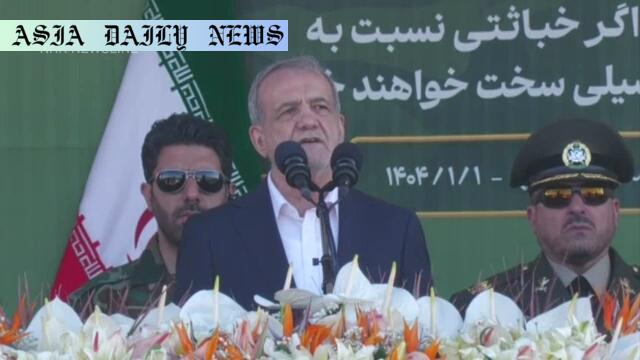Iran military parade showcases advanced technologies and restraint in rhetoric amidst upcoming US nuclear talks.

Iran Showcases Military Strength at Parade in Tehran
On Friday, Iran conducted a bold military parade in its capital, Tehran, highlighting its defense prowess with an impressive display of missiles, drones, and tanks. This annual event commemorates the country’s armed forces and their critical role as guardians of national sovereignty. The Iranian President, Masoud Pezeshkian, took the opportunity to applaud the nation’s advancements in military technology, emphasizing that Iran has achieved self-reliance in manufacturing critical defense equipment. This independence in defense production symbolizes a significant milestone in Iran’s quest to maintain sovereignty and resist external pressures from global powers.However, what truly stood out during this parade was President Pezeshkian’s unexpected rhetorical shift. Historically known for strongly worded critiques of both the United States and Israel, the president notably refrained from mentioning either nation in his speech this year. Instead, his address focused on lauding the bravery of the Iranian armed forces and affirming the country’s readiness to protect its borders. This change in tone did not go unnoticed and has fuelled discussions among observers regarding its implications amidst ongoing diplomatic exchanges.
Diplomatic Restraint as a Strategic Choice
Political analysts suggest that the absence of direct criticism of the United States might represent a calculated move. Just last week, senior officials from both nations described their recent discussions on Tehran’s nuclear program as ‘constructive.’ With a second round of talks scheduled imminently, President Pezeshkian’s rhetoric appears to align with a strategy of restraint, potentially to avoid any provocations that could undermine these delicate negotiations. Insights into this restraint suggest that Iran may be recalibrating its approach to global diplomacy, prioritizing constructive dialogue over confrontational rhetoric.Symbolism and Strategy in Military Displays
The parade not only showcased hardware but also delivered a subtle message. Featuring advanced missiles, drones, and tanks, the event demonstrated Iran’s robust military capabilities, reflecting its capacity to defend national interests independently. This self-reliance in technology aligns with Iran’s broader strategic narrative that emphasizes resistance to external domination and the ability to sustain its defense mechanisms internally. The country’s defense advances, declared with pride by President Pezeshkian, underscore a broader message of independence to both domestic and international observers.The Broader Context and Future Implications
This year’s parade arrives at a crucial time for Iran, with the nation at the crossroads of military advancements and diplomatic negotiations. The dual developments of a stronger domestic arsenal and a cautious approach to international diplomacy reveal a nuanced policy aimed at safeguarding national security while exploring avenues for constructive engagement. Whether this strategy leads to breakthroughs remains uncertain, but the optics of restraint alongside strength may resonate positively in global corridors of power. As discussions continue to unfold, Iran’s ability to balance military readiness with diplomatic channels will remain crucial in determining its trajectory on the world stage.Commentary
Iran’s Diplomatic Tightrope: A Strategic Shift
The recent military parade in Tehran provides much food for thought, not just in terms of Iran’s defense capabilities but also its changing dynamics on the diplomatic stage. Historically, Iranian officials have used forums such as this one to criticize their adversaries openly. However, President Pezeshkian’s deliberate omission of inflammatory rhetoric signifies a more calculated approach to diplomacy. This is a noteworthy shift and could indicate a larger shift in Iran’s foreign policy strategy as it strives toward balanced communication with global entities like the United States.While the display of missiles, drones, and tanks aims to project strength, the president’s refrained tone hints at a willingness to mend some bridges—albeit cautiously. This duality serves a larger purpose. On the one hand, Iran sends a clear message about its military readiness and independence. On the other hand, holding back on provocative speech aligns with recent constructive talks on Iran’s nuclear ambitions.
What cannot be ignored is the timing of this shift. As the second round of diplomatic talks approaches, Iran is aware that rhetoric could derail progress. Instead, by projecting an image of strength tempered with restraint, Tehran presents itself as a pragmatic actor on the world stage—one that is prepared to engage without compromising its values. Yet, this approach is not without risks. For many hardliners within Iran, any perceived softening might invite criticism. Thus, the Iranian leadership must balance domestic expectations with the realities of international diplomacy.


